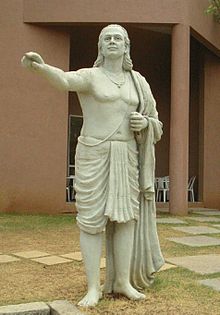阿耶波多
| 阿耶波多 आर्यभट | |
|---|---|
 印度校际天文及天体物理学中心的阿耶波多雕像,来自艺术家的想像,阿耶波多的真实样貌不明。 | |
| 出生 | 476年 可能是现今印度喀拉拉邦的阿萨玛卡 |
| 逝世 | 550年(73—74岁) |
| 居住地 | 印度 |
| 信仰 | 兴都教 |
| 学术工作 | |
| 年代 | 笈多王朝 |
| 主要领域 | 数学、天文学 |
| 著名作品 | 《 阿里亚哈塔历书》 |
| 著名思想 | 解释日食与月食的成因、地球自转、月球反射光、正弦函数、一元二次方程解、圆周率小数点后4位近似、99.8%精确度的地球周长、恒星年的长度 |
| 施影响于 | 婆罗摩笈多、伐罗诃密希罗 |
| 圆周率 |
|---|
 |
| 3.1415926535897932384626433... |
| 运用 |
| 证明 |
| 值 |
| 人物 |
| 历史 |
| 文化 |
| 相关主题 |
阿耶波多(梵语:आर्यभट、IAST: Āryabhaṭa[a],或译阿里亚哈塔,阿耶波多一世[2][3],公元476年-550年)[4][5]是5世纪末印度的著名数学家及天文学家。他的作品包括《阿里亚哈塔历书》[6],分四部分。书中提供了精确度达5个有效数字的圆周率近似值。此外,他还根据天文观测,提出日心说,并发现日月食的成因。另外,印度在1975年发射的第一颗人造卫星以他的名字命名。
生平
[编辑]根据阿里亚哈塔历书,阿耶波多于印度纪元中的争斗时3,600年(公元499年)写成该书,当时他23岁。这表示他出生于公元476年[5]。阿耶波多并未说明其出生地点。唯一的相关信息来自婆什迦罗第一,他描述阿耶波多为“āśmakīya”,亦即“属于阿萨玛卡国的人”。在佛陀在世期间,有一支阿萨玛卡人住在讷尔默达河和哥达瓦里河之间,阿耶波多被认为是出生于该地[1][7]。但也有部分学者认为阿耶波多出生在喀拉拉邦的格朗格努尔,并提出一些天文上的证据来支持其论点[8]。
阿耶波多曾前往库什马布拉进修,并在那里生活了一段期间[9]。根据兴都教与佛教传统,以及包含婆什迦罗第一的一些学者,皆认为库什马布拉就是巴连弗邑,也就是现在的巴特那 [1]。有段诗句提及阿耶波多曾领导一所位于库什马布拉的学院(kulapa),而由于当时那烂陀大学位于巴连弗邑,而且设有天文观测站,因此有学者推测阿耶波多也曾领导那烂陀大学[1]。阿耶波多也曾在位于比哈尔邦塔热嘎那的一间阿波罗庙建立一座天文观测站[10]。
数学
[编辑]估计圆周率
[编辑]阿耶波多曾进行圆周率之估计,并有可能得出圆周率值是无理数的结论。在《阿里亚哈塔历书》的第二部分,阿耶波多写道:
- 原文:
| “ |
caturadhikam śatamaṣṭaguṇam dvāṣaṣṭistathā sahasrāṇām |
” |
- 翻译:
| “ | ” |
这表示圆周率的值,也就是圆周与直径的比,是,其精确度达5个有效数字。有学者推断,阿耶波多使用“逼近”(āsanna)一词,可能不仅为了表示这是估计值,而是有意表示他是个无理数。同样,在中国,刘徽于公元263年求得一样的圆周率:;在欧洲,圆周率是无理数的证明由约翰·海因里希·朗伯在1761年发表[12]。在《阿里亚哈塔历书》于公元820年被翻译成阿拉伯文之后,这个估计值被花拉子米所著之代数书籍中被提及[7]。
三角学
[编辑]在《阿里亚哈塔历书》中的〈算数〉(Ganitapada)篇第6回,阿耶波多描述三角形的面积计算方式:
- 原文:
| “ | tribhujasya phalashariram samadalakoti bhujardhasamvargah | ” |
- 翻译:
| “ | 对于一个三角形,底的一半与高的乘积即为其面积[13] | ” |
阿耶波多也在该书中讨论正弦函数的概念,称之为“ardha-jya”,字面上为半弦之意。尔后,人们逐渐将其简称为“jya”。尔后其著作从梵文被译为阿拉伯文,该函数名则被译成“jiba”。然而,在阿拉伯文书写体系中母音被省略,于是该词变成了“jb”。到了12世纪,克雷莫纳的杰拉德将该书从阿拉伯文翻译成拉丁文时,因为“jiba”在阿拉伯文中没有对应的意义而误以为该字为“jaib”,意为“口袋”或“襞”。于是便译为拉丁文的对应词“sinus”,意为“海湾”,最后便演变为如今正弦函数的英文名“sine”。余弦函数(kojya,英语:cosine)亦是如此[14][15]。
代数
[编辑]在《阿里亚哈塔历书》中,阿耶波多推导出以下平方与立方级数求和之结果[16]:
以及
天文
[编辑]日月食
[编辑]阿耶波多认为,月球与行星并不会自行发光,而是反射太阳光。此外,他也解释了日月食的成因,说明日食是月球落在地球上的阴影、月食是地球落在月球上的阴影造成的。他也讨论了地球阴影的大小和范围,并计算出日月食的规模。后事的印度天文学家更基于阿耶波多的基础上,将预测做得更加精确。他们的计算是如此的精确,以至于18世纪科学家纪尧姆·勒让蒂尔造访印度本地治里时发现印度人对1765年8月30日月食的持续时间只比实际短了41秒,而他手上的预测表[b]则长了68秒[7]。
地球自转与公转周期
[编辑]若使用现今公制单位,阿耶波多当时求得之恒星日[c]长度为23小时56分4.1秒[17],而现代测得之精确值为23小时56分4.091秒。另外,阿耶波多求得之恒星年[d]长度为365天6小时12分30秒(365.25858天)[7]:13,只与现代测量值(365.25636天)相差3分20秒[18]。
以阿耶波多命名的事物
[编辑]
- 印度的第一颗人造卫星:阿耶波多人造卫星[19]。
- 月球上的陨石坑:阿耶波多陨石坑[19]。
- 邻近印度奈尼塔尔的阿耶波多观测科学研究学院(ARIES)[19] 。
- 印度空间研究组织在平流层发现的细菌:阿耶波多芽孢杆菌(学名:Bacillus aryabhata)[20]。
- 阿耶波多知识大学(AKU):印度比哈尔邦的一所大学[21]。
注释
[编辑]参见
[编辑]参考文献
[编辑]脚注
[编辑]- ^ 1.0 1.1 1.2 1.3 K. V. Sarma. Āryabhaṭa: His name, time and provenance (PDF). Indian Journal of History of Science. 2001, 36 (4): 105–115. (原始内容存档 (PDF)于2015-01-04) (英语).
- ^ Aryabhata the Elder. history.mcs.st-andrews.ac.uk. [2012-07-18]. (原始内容存档于2015-07-11) (英语).
- ^ Britannica Educational Publishing. The Britannica Guide to Numbers and Measurement. The Rosen Publishing Group. 2010-08-15: 97– [2012-07-18]. ISBN 978-1-61530-218-5. (原始内容存档于2015-09-02) (英语).
- ^ Bharati Ray. Different Types of History. Pearson Education India. 2009-09-01: 95– [2012-06-24]. ISBN 978-81-317-1818-6. (原始内容存档于2015-09-02) (英语).
- ^ 5.0 5.1 B. S. Yadav. Ancient Indian Leaps Into Mathematics. Springer. 2010-10-28: 88– [2012-06-24]. ISBN 978-0-8176-4694-3. (原始内容存档于2015-09-02) (英语).
- ^ Heidi Roupp. Teaching World History: A Resource Book. M.E. Sharpe. 1997: 112– [2012-06-24]. ISBN 978-1-56324-420-9. (原始内容存档于2015-09-02) (英语).
- ^ 7.0 7.1 7.2 7.3 Ansari, S.M.R. Aryabhata I, His Life and His Contributions. Bulletin of the Astronomical Society of India. March 1977, 5 (1): 10–18 [2011-01-22]. Bibcode:1977BASI....5...10A. (原始内容存档于2007-11-16) (英语).
- ^ Radhakrishnan Kuttoor, Aryabhata lived in Ponnani?, The Hindu, 2007-06-25, (原始内容存档于2007-07-01) (英语)
- ^ Cooke, Roger. The Mathematics of the Hindus. History of Mathematics: A Brief Course. 1997: 204 (英语).
Aryabhata himself (one of at least two mathematicians bearing that name) lived in the late 5th and the early 6th centuries at Kusumapura (Pataliutra, a village near the city of Patna) and wrote a book called Aryabhatiya.
- ^ Get ready for solar eclipe (PDF). National Council of Science Museums, Ministry of Culture, Government of India. [2009-12-09]. (原始内容 (PDF)存档于2011-07-21) (英语).
- ^ Jacobs, Harold R. Geometry: Seeing, Doing, Understanding (Third Edition). New York: W.H. Freeman and Company. 2003: 70. ISBN 0-7167-4361-2.
- ^ S. Balachandra Rao. Indian Mathematics and Astronomy: Some Landmarks. Bangalore: Jnana Deep Publications. 1998 [First published 1994]. ISBN 81-7371-205-0.
- ^ Roger Cooke. The Mathematics of the Hindus. History of Mathematics: A Brief Course. Wiley-Interscience. 1997. ISBN 0-471-18082-3.
Aryabhata gave the correct rule for the area of a triangle and an incorrect rule for the volume of a pyramid. (He claimed that the volume was half the height times the area of the base.)
- ^ Howard Eves. An Introduction to the History of Mathematics 6. Saunders College Publishing House, New York. 1990: 237.
- ^ Douglas Harper. Online Etymology Dictionary. 2001 [2007-07-14]. (原始内容存档于2007-07-13) (英语).
- ^ Boyer, Carl B. The Mathematics of the Hindus. A History of Mathematics Second. John Wiley & Sons, Inc. 1991: 207. ISBN 0-471-54397-7.
He gave more elegant rules for the sum of the squares and cubes of an initial segment of the positive integers. The sixth part of the product of three quantities consisting of the number of terms, the number of terms plus one, and twice the number of terms plus one is the sum of the squares. The square of the sum of the series is the sum of the cubes.
- ^ R.C.Gupta. Āryabhaṭa. Helaine Selin (编). Encyclopaedia of the history of science, technology, and medicine in non-western cultures. Springer. 1997-07-31: 72 [2011-01-22]. ISBN 978-0-7923-4066-9. (原始内容存档于2015-09-02) (英语).
- ^ Aryabhatiya 马拉提语:आर्यभटीय, Mohan Apte, Pune, India, Rajhans Publications, 2009, p.25, ISBN 978-81-7434-480-9
- ^ 19.0 19.1 19.2 Maths can be fun. The Hindu. 2006-02-03 [2007-07-06]. (原始内容存档于2007-10-01) (英语).
- ^ New Microorganisms Discovered In Earth's Stratosphere. ScienceDaily. 2009-03-18. (原始内容存档于2015-04-15) (英语).
- ^ Introduction. Aryabhatta Knowledge University. [2023-10-16]. (原始内容存档于2023-06-04) (英语).
参考书目
[编辑]- Cooke, Roger. The History of Mathematics: A Brief Course. Wiley-Interscience. 1997. ISBN 0-471-18082-3.
- Clark, Walter Eugene. The Āryabhaṭīya of Āryabhaṭa: An Ancient Indian Work on Mathematics and Astronomy. University of Chicago Press; reprint: Kessinger Publishing (2006). 1930. ISBN 978-1-4254-8599-3.
- Kak, Subhash C. (2000). 'Birth and Early Development of Indian Astronomy'. In Selin, Helaine (编). Astronomy Across Cultures: The History of Non-Western Astronomy. Boston: Kluwer. 2000. ISBN 0-7923-6363-9.
- Shukla, Kripa Shankar. Aryabhata: Indian Mathematician and Astronomer. New Delhi: Indian National Science Academy, 1976.
- Thurston, H. Early Astronomy. Springer-Verlag, New York. 1994. ISBN 0-387-94107-X.
外部链接
[编辑]- 互联网档案馆上沃尔特·尤金·克拉克于1930年所编的《阿里亚哈塔历书》英译本 ,有数种格式。(英文)
- 约翰·J·奥康纳; 埃德蒙·F·罗伯逊, Aryabhata_I, MacTutor数学史档案 (英语)(英文)
- Achar, Narahari. Āryabhaṭa I. Thomas Hockey; et al (编). The Biographical Encyclopedia of Astronomers. New York: Springer: 63. 2007 [2015-09-01]. ISBN 978-0-387-31022-0. (原始内容存档于2021-04-17). (PDF版 (页面存档备份,存于互联网档案馆))(英文)
- Aryabhata and Diophantus' son (页面存档备份,存于互联网档案馆),印度斯坦时报上的科学故事专栏,2004年11月。(英文)
- Surya Siddhanta translations (页面存档备份,存于互联网档案馆)(英文)




